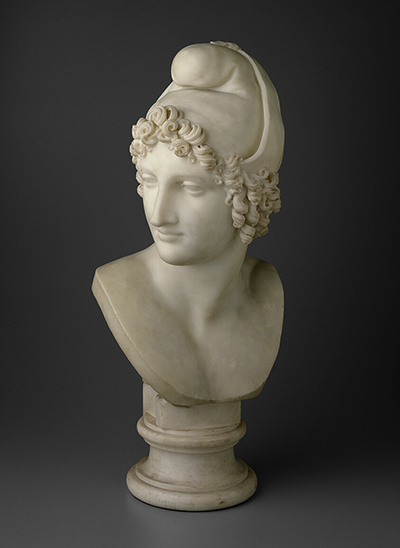This bust from 1809 was produced by Antonio Canova in conjunction with a fuller length piece which itself now resides in the State Hermitage Museum in Saint Petersburg, Russia. This smaller piece can be found in the Art Institute of Chicago, USA.
This Bust of Paris was created for Antoine Quatremère de Quincy who was already a good friend of the sculptor. She herself was heavily involved in the arts industry, though not an artist herself. Canova saw an opportunity to practice the facial elements of his larger commission through this project, whilst also providing a gift to a cherished friend. The story goes that Paris, a Shepherdess, was required to judge the beauty of three young women, namely Hera, Athena, and Aphrodite. Her gaze towards them is therefore captured within this portrait, precisely at the moment at which she considers the relative beauty of these goddesses. The sculptor's version is idealised, adapting the tale to deliver his perfect version of how she might have looked. The piece was well received, with one critic describing it as one of Canova's best sculptures due to its combination of "life, purity and softness". In total Paris would feature in close to a dozen different sculptures by Canova during his strong focus on this theme, with a mixture of several full length statues plus several more busts, like the one displayed here. It is fair to say that he really exhausted his ideas and inspiration on this topic and the majority of these pieces have become highly regarded by international art critics.
Antonio Canova is regarded by most as one of the most important Neoclassical artists, producing sculptures which merged the positive aspects of the Baroque and Classical eras. His work was predominantly in marble, but he also was an accomplished painter and draughtsman as well. He sits amongst the main group of Italian sculptors from the early Renaissance up to the 19th century who played such an important role in refreshing interest in this respected artistic discipline. He sits alongside other great names such as Gian Lorenzo Bernini who himself focused on sculpture and left behind his own impressive oeuvre. They followed in the footsteps of the likes of Michelangelo who had earlier innovated and impressed during the various periods of the Renaissance which would ultimately place Italy at the zenith of European art for several centuries, alongside perhaps the regions of Northern Europe which had gifted us the likes of Durer, Van Eyck and Bosch. Canova himself came later, but was still able to provide a unique voice due to his technical abilities and a smooth fusion of influences within his work.
Depending on the size, of course, sculptures can take much longer to produce than paintings and drawings, meaning that most sculptors' oeuvres are relatively small in comparison to the painting colleagues. Additionally, Canova worked across several different mediums and so required additional time to learn and develop his knowledge and technical skills within each one, rather than if he had just focused on a single discipline. Aside from this Bust of Paris, other notable pieces that he contributed to the field of Neoclassical sculpture were the likes of Psyche Revived by Cupid's Kiss, Venus Victrix andThe Three Graces all of which are considered to have been true masterpieces of that era. Even today his career is celebrated frequently, with exhibitions around the world aiming to loan elements of his output and display them to new audiences who marvel at the softness and accuracy of his use of marble, even though the interest in classical sculpture is not as high as it once was.




